Wednesday, July 27, 2005
GroundVenture 2005
by Tom Bozzo
Our ground conveyance. Considering that it would happily cruise at 110kt if only the law would allow, a bargain compared to the avian alternative (q.v.).
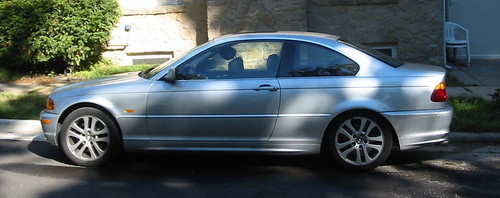
The boy is ready for action!

(Still) on the ground in Oshkosh.
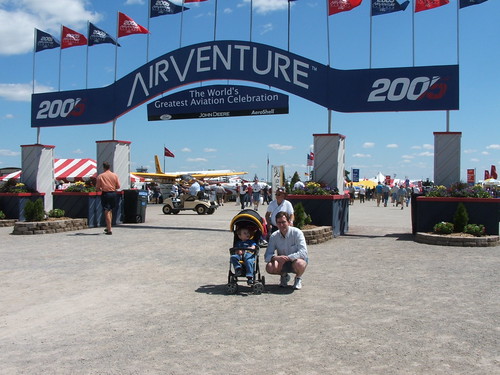
AirVenture is, among other things, an enormous general aviation marketplace. Here are some people checking out the Cirrus SR22, a modern piston-engined single.

The very modern cockpit of the Cirrus.
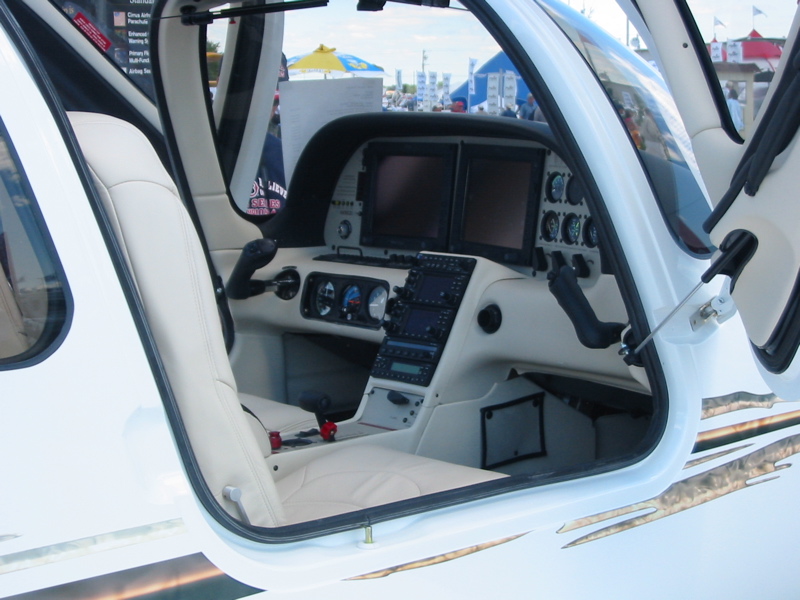
D'Ohh — the heart-attack inducing price!

Not my grandfather's Cessna Skyhawk instrument panel.
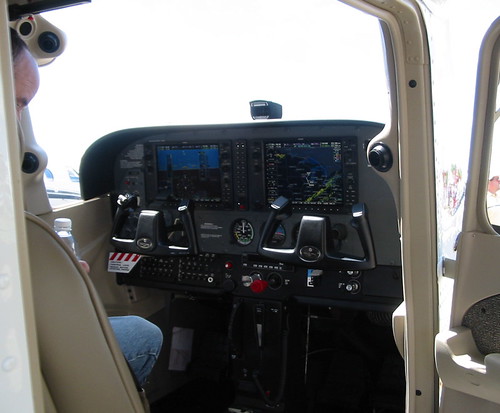
Nope, still can't afford it. At least this one's closer to half the price of my house.
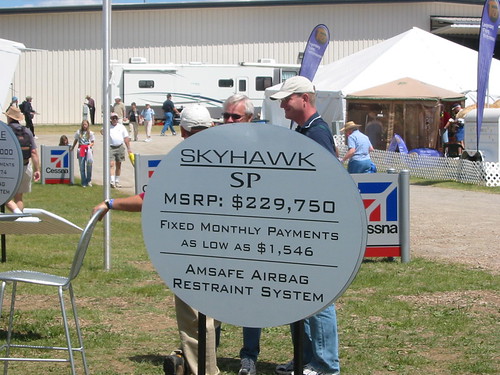
A prototype Eclipse 500, a small jet aimed at the air taxi market. I look forward to my liberation from the airlines, depending on just which market the oil peak kills off first.
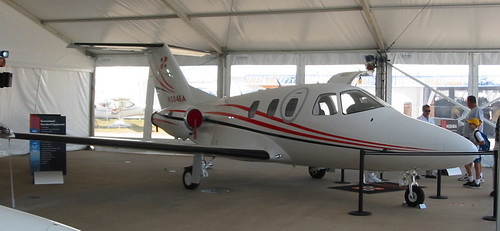
Two of the Eclipses also gave their first public flying display. Here they are in formation.
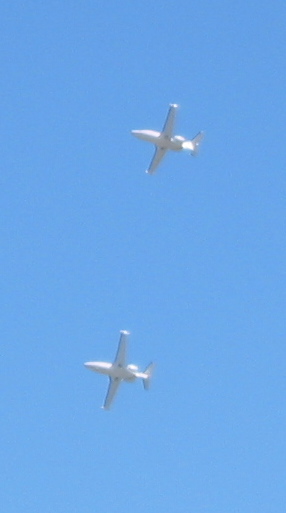
There was ground-oriented stuff going on, too, at a big Ford-sponsored tent. Here, I try on the '06 Miata for size. If I had a garage to put it in, I'd take one.
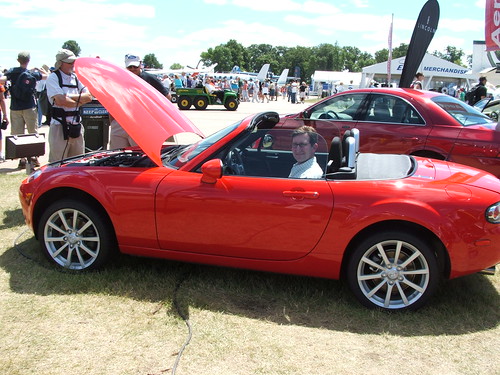
That Ford Focus has a fuel cell under the hood.
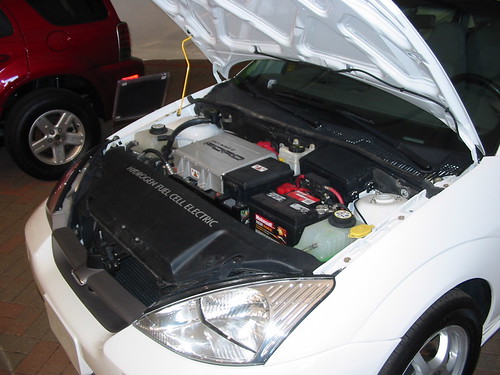
Carroll Shelby was explaining that Ford doesn't have the money to develop a V-12 for his supercars. Funny, in that Ford owns Aston Martin, and some Astons have twelves. Anyhoo...

I will never again complain about how hard it is to maintain plausible deniability that my car is silver. The Shelby GR-1 show car shows fingerprints with astonishing ease.

The Piaggio Avanti is a bizarro twin-turboprop.
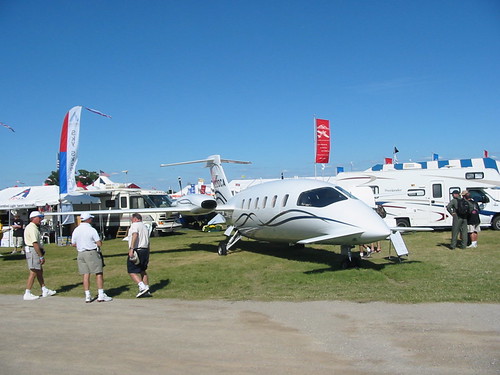
Inside the Avanti. The Smell-O-Web would tell you that this is upholstered in really nice leather.
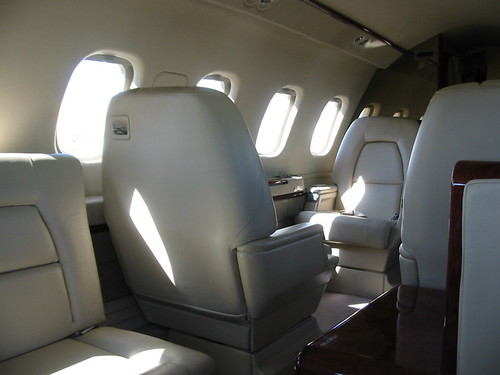
The White Knight and SpaceShipOne were mobbed in their role as stars of the show.
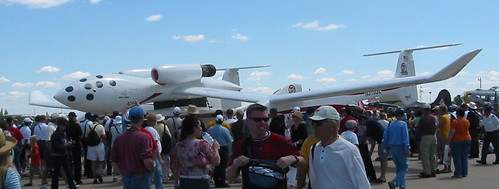
A little closer than he'll get at the Air and Space Museum?
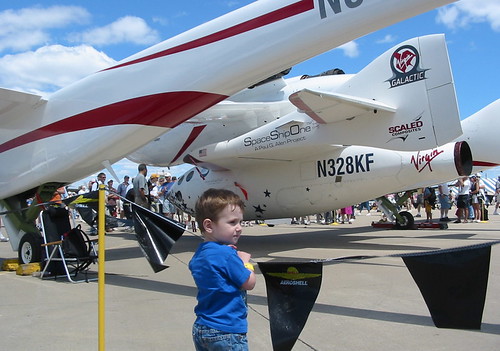
Another view of the pair.
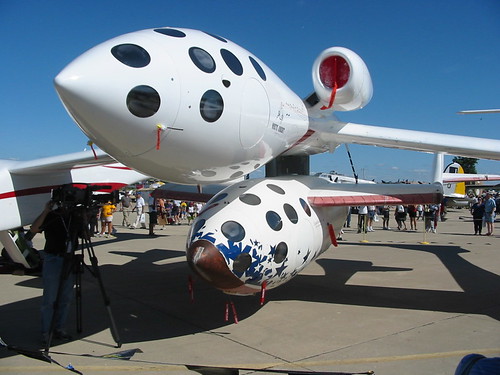
The Rutan influence was widely felt at AirVenture, including at this field full of Long-EZ homebuilts.
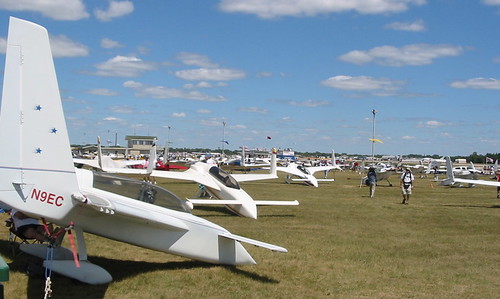
A C-54 (Douglas DC-4) of Berlin Air Lift vintage.

Catching some shade from a C-130.
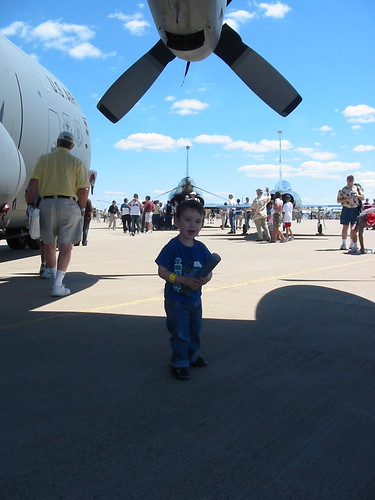
Note for future visits: while the official air show starts around 3:30, there are nearly constant flying displays.
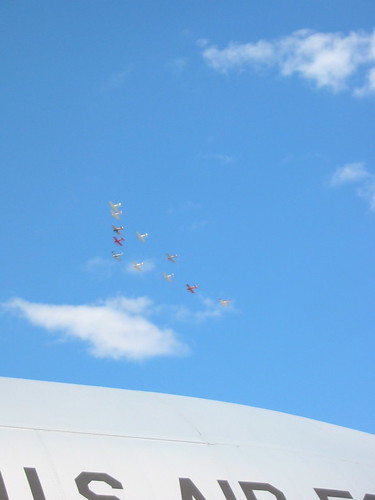
Waiting for a wing walker.
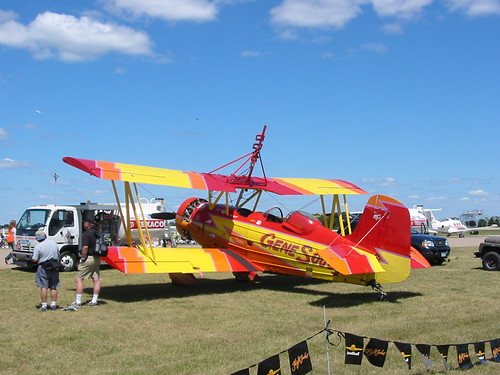
This fellow is about to transfer himself from the Stearman to the skid of that helicopter. He is not wearing a parachute. This is the second pass. You haven't lived until you've seen a helicopter do a tailslide and fly backwards in lieu of circling around.
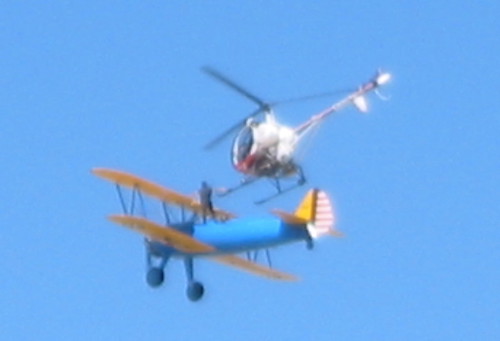
A lovingly restored P-51 taxis out for the show. It's good to be a Microsoft billionaire (if I heard the announcer right, Paul Allen apparently owns this one, too).
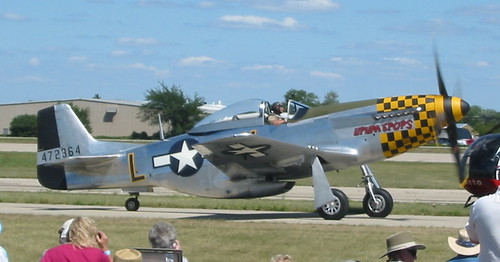
The Virgin Global Flyer was supposed to have flown to Oshkosh yesterday, but was delayed a day due to foul midwestern weather. This was for the benefit of today's crowd — here, a low pass over the field.
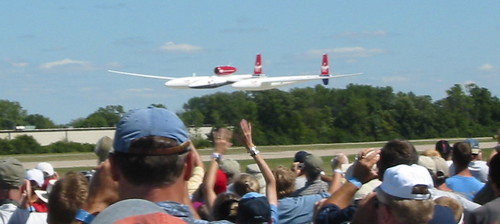
And safely on the ground.

Steve Fossett (at podium) addresses the throngs, accompanied by Sir Richard (at left). FAA Administrator Marion Blakey was also on hand to welcome Fossett and the Flyer, also NASM-bound.
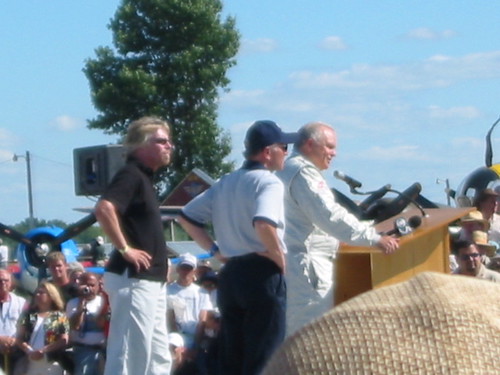
The warbirds were moving too darn fast for my poor point-and-shoot digital. I am so getting an SLR and telephoto lens for next year. Here's part of the final display.
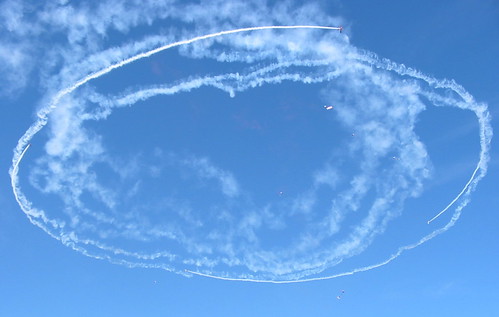
Woohoo! I took a toddler to AirVenture and lived — with the assistance of a yummy half-drunk martini — to blog about it. I have to say (or brag, no Wednesday whine for me this week) that John was the model toddler, even though he was probably more interested in the hot dog and freedom fries for lunch than the enormous array of aircraft surrounding him. I'll have a chance to work on him for '06, in any event. Here's the adventure in pictures.
Our ground conveyance. Considering that it would happily cruise at 110kt if only the law would allow, a bargain compared to the avian alternative (q.v.).

The boy is ready for action!

(Still) on the ground in Oshkosh.

AirVenture is, among other things, an enormous general aviation marketplace. Here are some people checking out the Cirrus SR22, a modern piston-engined single.

The very modern cockpit of the Cirrus.

D'Ohh — the heart-attack inducing price!

Not my grandfather's Cessna Skyhawk instrument panel.

Nope, still can't afford it. At least this one's closer to half the price of my house.

A prototype Eclipse 500, a small jet aimed at the air taxi market. I look forward to my liberation from the airlines, depending on just which market the oil peak kills off first.

Two of the Eclipses also gave their first public flying display. Here they are in formation.

There was ground-oriented stuff going on, too, at a big Ford-sponsored tent. Here, I try on the '06 Miata for size. If I had a garage to put it in, I'd take one.

That Ford Focus has a fuel cell under the hood.

Carroll Shelby was explaining that Ford doesn't have the money to develop a V-12 for his supercars. Funny, in that Ford owns Aston Martin, and some Astons have twelves. Anyhoo...

I will never again complain about how hard it is to maintain plausible deniability that my car is silver. The Shelby GR-1 show car shows fingerprints with astonishing ease.

The Piaggio Avanti is a bizarro twin-turboprop.

Inside the Avanti. The Smell-O-Web would tell you that this is upholstered in really nice leather.

The White Knight and SpaceShipOne were mobbed in their role as stars of the show.

A little closer than he'll get at the Air and Space Museum?

Another view of the pair.

The Rutan influence was widely felt at AirVenture, including at this field full of Long-EZ homebuilts.

A C-54 (Douglas DC-4) of Berlin Air Lift vintage.

Catching some shade from a C-130.

Note for future visits: while the official air show starts around 3:30, there are nearly constant flying displays.

Waiting for a wing walker.

This fellow is about to transfer himself from the Stearman to the skid of that helicopter. He is not wearing a parachute. This is the second pass. You haven't lived until you've seen a helicopter do a tailslide and fly backwards in lieu of circling around.

A lovingly restored P-51 taxis out for the show. It's good to be a Microsoft billionaire (if I heard the announcer right, Paul Allen apparently owns this one, too).

The Virgin Global Flyer was supposed to have flown to Oshkosh yesterday, but was delayed a day due to foul midwestern weather. This was for the benefit of today's crowd — here, a low pass over the field.

And safely on the ground.

Steve Fossett (at podium) addresses the throngs, accompanied by Sir Richard (at left). FAA Administrator Marion Blakey was also on hand to welcome Fossett and the Flyer, also NASM-bound.

The warbirds were moving too darn fast for my poor point-and-shoot digital. I am so getting an SLR and telephoto lens for next year. Here's part of the final display.

Comments:
<< Home
Airbags?! they've got to be kidding. Is it really possible to crash one of these small planes & be saved by airbags?
Looked like a fantastic day for an airshow
Looked like a fantastic day for an airshow
Great pics! I went up to the EAA airshow a few years back and enjoyed it. It looks like it has gotten better with big time exhibits like SpaceShip One.
Cathy: The weather was fabulous. It was so cool that I should have worn long pants like the boy -- my inadequately sunblocked legs got a bit burnt.
As for the airbags, they probably would be effective in some real-world situations. The certification rules for light planes ensure that take-off and landing speeds are similar to highway speeds, so in many small plane accidents the crash forces themselves won't automatically kill you. They add relatively little to the cost of the planes, so they arguably make sense to have.
"Ballistic recovery systems" are the other big thing in small plane safety. Those are enormous parachutes for the entire plane that can be deployed in some (though not all) circumstances where the pilot loses control.
Bryan: Thanks! I think the profile of the event has risen overall, though the last few years it's been my impression that there have been some "blockbuster" appearances each year. (E.g., Concorde on a retirement tour.) I think this year may have been a bit unusual, though, in that some of the most newsworthy aircraft like SpaceShipOne actually belong more-or-less to the general aviation world.
As for the airbags, they probably would be effective in some real-world situations. The certification rules for light planes ensure that take-off and landing speeds are similar to highway speeds, so in many small plane accidents the crash forces themselves won't automatically kill you. They add relatively little to the cost of the planes, so they arguably make sense to have.
"Ballistic recovery systems" are the other big thing in small plane safety. Those are enormous parachutes for the entire plane that can be deployed in some (though not all) circumstances where the pilot loses control.
Bryan: Thanks! I think the profile of the event has risen overall, though the last few years it's been my impression that there have been some "blockbuster" appearances each year. (E.g., Concorde on a retirement tour.) I think this year may have been a bit unusual, though, in that some of the most newsworthy aircraft like SpaceShipOne actually belong more-or-less to the general aviation world.
It's no surprise that the Vari-Eze evolved into the Long-EZ and that elements of those designs turned up in the 1986 Voyager, the Branson-Rutan successor, and the reusable rocket plane. This convention is of the Experimental Aircraft Association, after all, and at one time the passenger ships and the warbirds were themselves experimental.
The coolest demonstration of this point was the 1986 touchdown of Voyager, which was escorted back to base by a couple of Cessnas.
The coolest demonstration of this point was the 1986 touchdown of Voyager, which was escorted back to base by a couple of Cessnas.
Stephen: good point. I probably should have said "experimental civil aviation" rather than "general aviation" at the end of the last comment.
I did neglect to mention that this was the 30th anniversary of the appearance of the Vari-Eze at EAA.
I did neglect to mention that this was the 30th anniversary of the appearance of the Vari-Eze at EAA.
You know, that Avanti looks an awful lot like the classic Beechcraft Starship. I wonder if there's any sort of evolutionary connection between them.
The Avanti and the Starship were both developed around the same time and with similar goals (jet-like performance from a relatively efficient turboprop), which could account for the common use of the canard/pusher propeller configuration. As for a direct evolutionary heritage, the usual online sources aren't telling me much about the Avanti's design history. The timeline is such that it certainly could have been influenced by the Rutan designs of the mid-seventies, though the Avanti's wing and tail configuration is much different from that of the Starship (a Rutan design directly descended from the Vari-Eze).
Post a Comment
<< Home


